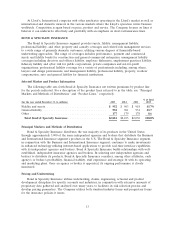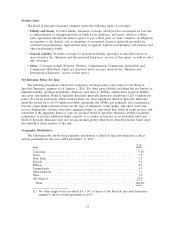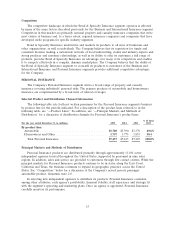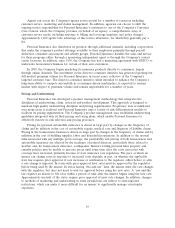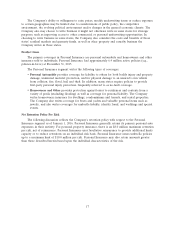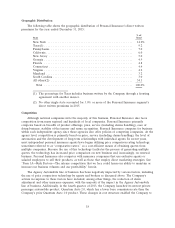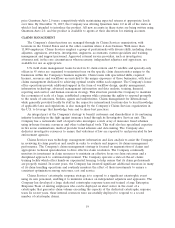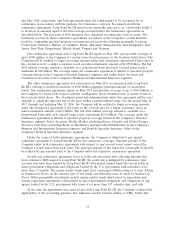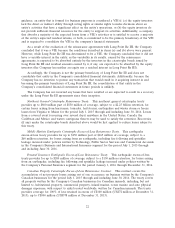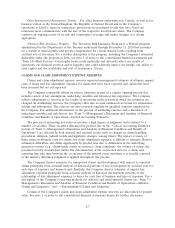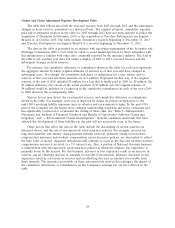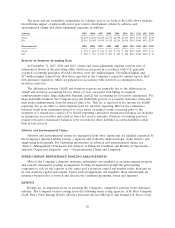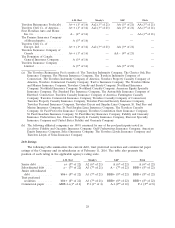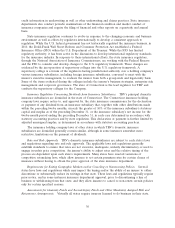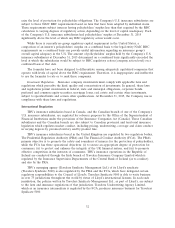Travelers 2015 Annual Report Download - page 23
Download and view the complete annual report
Please find page 23 of the 2015 Travelers annual report below. You can navigate through the pages in the report by either clicking on the pages listed below, or by using the keyword search tool below to find specific information within the annual report.Other International Reinsurance Treaties. For other business underwritten in Canada, as well as for
business written in the United Kingdom, the Republic of Ireland, Brazil and in the Company’s
operations at Lloyd’s, separate reinsurance protections are purchased locally that have lower net
retentions more commensurate with the size of the respective local balance sheet. The Company
conducts an ongoing review of its risk and catastrophe coverages and makes changes as it deems
appropriate.
Terrorism Risk Insurance Program. The Terrorism Risk Insurance Program is a Federal program
administered by the Department of the Treasury authorized through December 31, 2020 that provides
for a system of shared public and private compensation for certain insured losses resulting from
certified acts of terrorism. For a further description of the program, including the Company’s estimated
deductible under the program in 2016, see note 5 of notes to the consolidated financial statements and
‘‘Item 1A—Risk Factors—Catastrophe losses could materially and adversely affect our results of
operations, our financial position and/or liquidity, and could adversely impact our ratings, our ability to
raise capital and the availability and cost of reinsurance’’ herein.
CLAIMS AND CLAIM ADJUSTMENT EXPENSE RESERVES
Claims and claim adjustment expense reserves represent management’s estimate of ultimate unpaid
costs of losses and loss adjustment expenses for claims that have been reported and claims that have
been incurred but not yet reported.
The Company continually refines its reserve estimates as part of a regular ongoing process that
includes review of key assumptions, underlying variables and historical loss experience. The Company
reflects adjustments to reserves in the results of operations in the periods in which the estimates are
changed. In establishing reserves, the Company takes into account estimated recoveries for reinsurance,
salvage and subrogation. The reserves are also reviewed regularly by qualified actuaries employed by
the Company. For additional information on the process of estimating reserves and a discussion of
underlying variables and risk factors, see ‘‘Item 7—Management’s Discussion and Analysis of Financial
Condition and Results of Operations—Critical Accounting Estimates.’’
The process of estimating loss reserves involves a high degree of judgment and is subject to a
number of variables. These variables (discussed by product line in the ‘‘Critical Accounting Estimates’’
section of ‘‘Item 7—Management’s Discussion and Analysis of Financial Condition and Results of
Operations’’) are affected by both internal and external events, such as changes in claims handling
procedures, inflation, judicial trends and legislative changes, among others. The impact of many of
these items on ultimate costs for claims and claim adjustment expenses is difficult to estimate. Reserve
estimation difficulties also differ significantly by product line due to differences in the underlying
insurance contract (e.g., claims-made versus occurrence), claim complexity, the volume of claims, the
potential severity of individual claims, the determination of the occurrence date for a claim, and
reporting lags (the time between the occurrence of the insured event and when it is actually reported
to the insurer). Informed judgment is applied throughout the process.
The Company derives estimates for unreported claims and development with respect to reported
claims principally from actuarial analyses of historical patterns of loss development by accident year for
each type of exposure and business unit. Similarly, the Company derives estimates of unpaid loss
adjustment expenses principally from actuarial analyses of historical development patterns of the
relationship of loss adjustment expenses to losses for each line of business and type of exposure. For a
description of the Company’s reserving methods for asbestos and environmental claims, see ‘‘Item 7—
Management’s Discussion and Analysis of Financial Condition and Results of Operations—Asbestos
Claims and Litigation,’’ and ‘‘—Environmental Claims and Litigation.’’
Certain of the Company’s claims and claim adjustment expense reserves are discounted to present
value. See note 1 of notes to the consolidated financial statements herein for further discussion.
23


